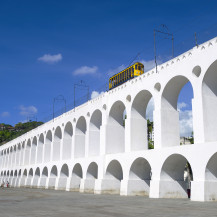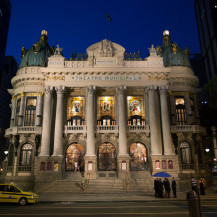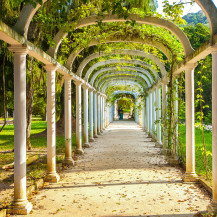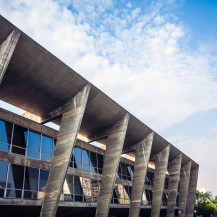Art, History and Culture in Rio
2 daysRio de Janeiro is the brazilian city with the most art and architecture treasures, with several buildings of the colonial period that are still preserved.
Before we start talking about the architectural and artistic treasures of the capital of Rio de Janeiro, it is important to remember that the Portuguese Court moved there in 1808, when Brazil was still a colony of Portugal, this would change profoundly the city in many aspects and would preserve, in Brazilian territory, structures of that time.
The historical beauty of Rio de Janeiro, however, is not only its precious architecture. Modernism also landed in Rio de Janeiro, of course. In 2011, the Wonderful City received the Wallpaper Architecture Awards (one of the most celebrated design awards in the world), ahead of Chicago (United States), Johannesburg (South Africa), Oslo (Norway) and Hong Kong.
The Historic Centre of Rio de Janeiro is full of old buildings, but preserved by time. Surrounded by the famous Avenida Rio Branco, Cinelândia (as the Praça Floriano is commonly known, right in the center of the Wonderful City) maintains structures like the Odeon Cinema, open in 1926; the National Library of Brazil, whose foundation has 206 years; the Municipal Theatre, which came into operation in 1909; In addition to the former Supreme Court, when Rio de Janeiro was the capital of Brazil.
Walk trough the Avenida Rio Branco until the Largo da Carioca, where the Convento de Santo Antonio is located, a building of historical importance. Next to the Igreja da Ordem Terceira de São Francisco da Penitência, it forms one of the oldest and most colonial assemblies, still standing, in the city of Rio de Janeiro. Nearby, the Candelária Church is another important and indispensable tour. Its construction occurred between 1609 and 1811.
A typical Rio de Janeiro district, Santa Teresa was born around a convent in the 18th century and now occupies a hillside in the heart of the city. A symbol of fine arts, the district’s narrow streets bustle with dozens of art studios and old trams, which can only be found in Rio and the city of Santos, in the state of São Paulo.
The original characteristics of the Santa Teresa tram were preserved and its external features were listed as a National Heritage by the State Government in 1983. The trip begins in the downtown area, passing through Arcos da Lapa and the district’s slopes, and landmarks such as Parque das Ruínas – an observatory with an amazing view of Rio de Janeiro.
Open to the general public, the Park is what is left of the Murtinho Nobre Villa, where Laurinda Santos Lobo lived – a patron who hosted gatherings for intellectuals and artists in the early 20th century. The Villa was one of the highlights of Rio’s cultural life until Laurinda died in 1946.
The Botanical Garden is one of the best preserved green areas of Rio de Janeiro, home to very valuable monuments from an artistic and archaeological point of view. The history of the place begins in 1808, when the Portuguese Crown moved to Brazil.
In the visitor center it is possible to notice the weight of history contained in the botanical gardens. The old architecture houses art exhibitions and is where you can request a guided tour, as well as other information in several languages. Don't be shy.
The alleys of Royal Palms, an Antillean plant that was first planted in Brazil in the Garden by Dom João VI, in 1809, bear the names of former directors of the Botanical Garden, most from the 19th century. In their center, you will find one of the most beautiful buildings: the Chafariz das Musas, consisting of two bowls manufactured in England. The structure arrived in the Botanical Gardens only in 1905. Another historic building is the Aqueduto da Levada. Listed as a historical landmark in 2005, it is quite old, dating from 1853, and was built to bring water to the gardens.
The Solar da Imperatriz is connected to the old Engenho de Nossa Senhora da Conceição, of 1575. The Engenho and other 50 farms make up a vast colonial farm, the first of Rio de Janeiro. Finally, the Casa dos Pilões is the archaeological center due to the manufacture of gunpowder.
Opened in 1948, the Museum of Modern Art is one of Brazil’s most prominent cultural institutions, located in a prime area of Rio de Janeiro. The building is surrounded by gardens in Aterro do Flamengo, near the Santos Dumont Airport and the downtown area.
The collection currently has approximately 6,500 items, including paintings, sculptures and engravings. One of the Museum’s highlights is the Joaquim Paiva collection, gathering 2,500 images from photographers across 22 countries, and the Gilberto Chateaubriand collection, featuring works by Anita Malfatti, Carlos Vergara, Di Cavalcanti, and Djanira, among others.
At the end of the tour, go to Ipanema, that is near the Botanical Garden. Even more irresistible than the muse that inspired the song “Girl from Ipanema”, by Vinícius de Moraes and Tom Jobim, Ipanema is a famous meeting point in Rio de Janeiro. With a sophisticated and intense nightlife, it combines beach, bars and shops.
Great for
See our recommendations
-
Craft fairs for you to return home with a full suitcase
-
The excitement of the Brazilian nights
-
4 parks to skateboard in the main capitals of Brasil
-
Football is in the genes of the Brazilian people
-
5 hiking trails to horse hide
-
12 shopping centers for you to return home with full suitcases
-
Cultural traditions that make Brazil a unique place




